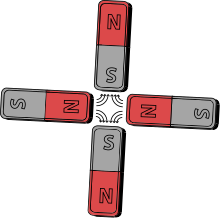Magnetism
From Wikipedia, the free encyclopedia
"Magnetic" redirects here. For other uses, see Magnetic (disambiguation) and Magnetism (disambiguation).
A magnetic quadrupole
| Electromagnetism |
|---|
 |
|
The magnetic state (or magnetic phase) of a material depends on temperature and other variables such as pressure and the applied magnetic field. A material may exhibit more than one form of magnetism as these variables change.
Contents
- 1 History
- 2 Sources of magnetism
- 3 Materials
- 4 Electromagnet
- 5 Magnetism, electricity, and special relativity
- 6 Magnetic fields in a material
- 7 Magnetic force
- 8 Magnetic dipoles
- 9 Quantum-mechanical origin of magnetism
- 10 Units
- 11 Living things
- 12 See also
- 13 References
- 14 Further reading
- 15 External links
History
Main article: History of electromagnetism
Drawing of a medical treatment using magnetic brushes. Charles Jacque 1843, France.
In ancient China, the earliest literary reference to magnetism lies in a 4th-century BC book named after its author, The Master of Demon Valley.[3] The 2nd-century BC annals, Lüshi Chunqiu, also notes: "The lodestone makes iron approach, or it attracts it."[4] The earliest mention of the attraction of a needle is in a 1st-century work Lunheng (Balanced Inquiries): "A lodestone attracts a needle."[5] The 11th-century Chinese scientist Shen Kuo was the first person to write – in the Dream Pool Essays – of the magnetic needle compass and that it improved the accuracy of navigation by employing the astronomical concept of true north. By the 12th century the Chinese were known to use the lodestone compass for navigation. They sculpted a directional spoon from lodestone in such a way that the handle of the spoon always pointed south.


frefr
ReplyDeleteu7igu7yg
ReplyDelete